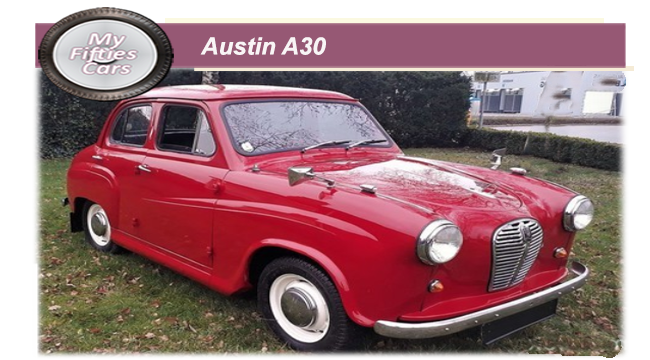
Austin first introduced their A30 at the Earls Court Show in 1951, as a part of their early post-war drive to revamp their model range. The company's goal was to establish a foothold in the world market for medium-sized cars.
T he Austin A30’s development had begun in 1949, in line with the company's post-war policy of designating its cars according to the approximate power output of the engine.
The A30 was the smallest and least powerful in the Austin “pecking order” with a small 803 cc engine capable of generating just 30 bhp. This tiny engine was the first incarnation of the A-series unit that would later go on to power the Mini, among others.
he Austin A30’s development had begun in 1949, in line with the company's post-war policy of designating its cars according to the approximate power output of the engine.
The A30 was the smallest and least powerful in the Austin “pecking order” with a small 803 cc engine capable of generating just 30 bhp. This tiny engine was the first incarnation of the A-series unit that would later go on to power the Mini, among others.
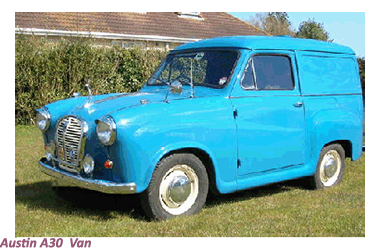 The A30's rounded body and prominent grille hinted at US styling influences, but in size, it was utterly European.
Although the car was extremely narrow, it had the advantage of offering considerable headroom, meaning that four adults could sit (very upright) in reasonable comfort. Initially available just as a two-door, although in response to demand, a four-door option was soon made available.
The A30's rounded body and prominent grille hinted at US styling influences, but in size, it was utterly European.
Although the car was extremely narrow, it had the advantage of offering considerable headroom, meaning that four adults could sit (very upright) in reasonable comfort. Initially available just as a two-door, although in response to demand, a four-door option was soon made available.
 A full-width parcel shelf ran beneath the facia panel.
The original cloth headlining gave way to one of washable plastic, while new and less austere door trims also helped to improve the interior scene.
A full-width parcel shelf ran beneath the facia panel.
The original cloth headlining gave way to one of washable plastic, while new and less austere door trims also helped to improve the interior scene.
![]()
A slight redesign of the seating arrangements resulted in three inches more knee room for the rear seat passengers, three inches more cushion width for those in front, and two inches more headroom.
O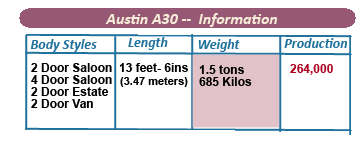 n the two-door version, the front passenger seat hinged along its front lower edge as well as featuring a hinged squab, an arrangement which made for easy access to the rear compartment, while the side windows at the rear also featured a chrome-plated surround, and were hinged to open outwards from their forward edge.
n the two-door version, the front passenger seat hinged along its front lower edge as well as featuring a hinged squab, an arrangement which made for easy access to the rear compartment, while the side windows at the rear also featured a chrome-plated surround, and were hinged to open outwards from their forward edge.
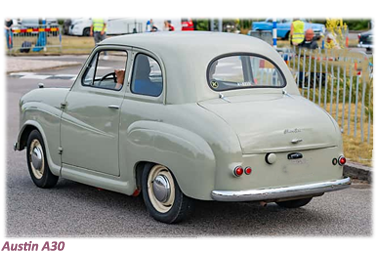 To improve the A30’s fuel economy still further, a new axle ratio of 4.875:1 was adopted early in 1954 which brought figures in excess of 50mpg (21 k/ph) within reach of the careful driver.
To improve the A30’s fuel economy still further, a new axle ratio of 4.875:1 was adopted early in 1954 which brought figures in excess of 50mpg (21 k/ph) within reach of the careful driver.
Later in 1954, a surprisingly roomy estate car — the A30 Countryman — was added to the range, based on the recently introduced A30 5cwt van, featuring the same roofline and general rear end appearance apart from the addition of large sliding rear side windows.
 With the rear seat in its upright position the interior was virtually identical to the saloon, but with the seat squab folded flat, at which its height, then matched that of the rear platform, a continuous loading length of 4 feet 5 inches (1.35 meters) was provided.
With the rear seat in its upright position the interior was virtually identical to the saloon, but with the seat squab folded flat, at which its height, then matched that of the rear platform, a continuous loading length of 4 feet 5 inches (1.35 meters) was provided.
![]()
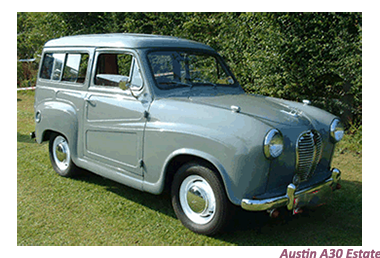 lthough aimed very much at the economy end of the market, the new small Austin nonetheless featured chrome plated finish for the bumpers, hubcaps, door handles, lamps, radiator grille, and the traditional "Flying A" bonnet motif.
lthough aimed very much at the economy end of the market, the new small Austin nonetheless featured chrome plated finish for the bumpers, hubcaps, door handles, lamps, radiator grille, and the traditional "Flying A" bonnet motif.
 The overall styling of the A30 was slightly marred by the use of external door hinges, and the separately mounted side lamps on the top of the front wings.
Thicker sheet steel than elsewhere was used at strategic points, such as the front suspension mountings; and the result of all this was an incredibly light yet adequately sturdy four-door bodyshell of compact overall dimensions, which would nevertheless comfortably accommodate four people plus a moderate amount of luggage.
The overall styling of the A30 was slightly marred by the use of external door hinges, and the separately mounted side lamps on the top of the front wings.
Thicker sheet steel than elsewhere was used at strategic points, such as the front suspension mountings; and the result of all this was an incredibly light yet adequately sturdy four-door bodyshell of compact overall dimensions, which would nevertheless comfortably accommodate four people plus a moderate amount of luggage.
